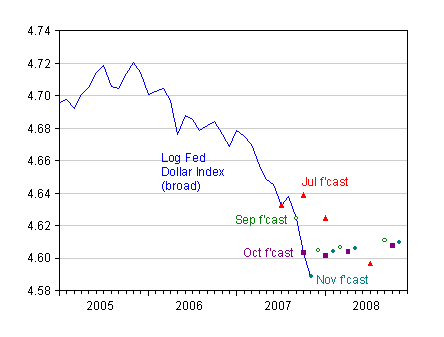Some analysts think so.
I’ve gone through some earlier forecasts to see what they’ve indicated about market views of the dollar’s trajectory.

Figure 1: Log nominal broad trade-weighted value of the dollar (blue), and implied forecasts for dollar value for July (red triangles), September (green circles), October (purple squares) and November (teal diamonds). Source: Fed, Deutsche Bank Exchange Rate Perspectives, various issues, and author’s calculations.
The broad trade-weighted value of the (nominal) dollar in blue has clearly been declining. In July, before the onset of the asset-backed corporate paper market experienced its first bout of turmoil, dollar depreciation was anticipated over the longer horizon (red triangles), but only about 4% in log terms by August 2008 (these are Deutsche Bank forecasts, but my impression is that these forecasts are not too different from market consensus). The dollar depreciated much faster than anticipated, so that by September 2008, the dollar’s value against a broad basket was about what was expected for February. Expectations were revised in September (green open circles) to anticipate a depreciation over the next three months, with stabilization thereafter. October’s forecast projected slight appreciation, as the dollar dropped over 2% from its September value. Finally, in Mid-November, with the dollar lower by over another percent, the predicted path of the dollar (green diamonds) was still largely unchanged relative to October (and even September) forecasts.
[One caveat is that I am assuming the DB dollar index is similar to the Fed’s broad trade weighted index, and used the projected changes in the DB dollar index to impute the projected change in the Fed’s broad index. Over the period of focus (July to November 2007), the Fed narrow and broad indices move in a similar fashion, although the narrow index moves down slightly faster.]
So, it would seem that the market does believe there is a floor beneath which the dollar will not fall. I suspect this is based mostly on a view about where interest rates are going in the euro area, and other major industrial-country economies (not an unreasonable approach; see this post). This definitely makes sense from a Taylor rule perspective on exchange rate fundamentals, as discussed in Engel-West, and Molodtsova and Papell, for instance.
These forecasts we see (both here and elsewhere) are measures of central tendency, which are (tautologically) going to ascribe low weight to low-probability events. And this is where Brad Setser‘s observation that the depreciation-to-date has mostly been against floating currencies. If the central banks that peg or tightly manage their currencies diversify slowly, then these forecasts with a floor on the value of the dollar still make sense. If there is a set of discrete breaks in dollar pegs (think the GCC countries), then one could imagine the floor on the dollar being somewhat lower…
Technorati Tags: dollar,
exchange rate,
central bank reserves,
depreciation.
rogoff in an article at syndicated project thinks the other way. The financial crisis is far from over and I think there will a secular growth recession in the following years, too much debt to be serviced and partially ill-invested.
Seems to me that the dollar’s depreciation against the euro did not solve any global imbalances that policmakers have been touting – we’ve simply depreciated the American dollar and put in its place an overvalued euro.
And when the Asian currencies finally do appreciate, American and European producers will finally get what they’ve been pushing for – but we will also get a taste of the disadvantages of a cheaper domestic currency.
carmelo cortes: You might be misconstruing my point — I freely allow that there might be continued depreciation. A continuation of the financial crisis might or might not weaken the dollar further. If the asset backed securities markets deteriorate in countries abroad as well, then they too may be forced to drop policy rates, thereby taking pressure off the dollar. So the manner in which the financial crisis evolves is important.
Sam W.: The US trade deficit has stabilized and shrunk as a share of GDP. Part of this outcome is partly due to a weaker dollar.
I have mentioned this in the past, but I will do this again.
This post although shows that you are doing great research doesnt make things CLEAR on any front.
From reading this post, do you think people can understand what is the “inference” you are making
The HEADING READS…”Is the Dollar Near the Bottom?” which makes one go into the post with the expectation that there is an ANSWER INSIDE.
But there is hardly any.
Its worthwhile to succintly sum up in the last para on what your answer is…
otherwise its a pot pourri of some random observations and links to varying view points unrelated to the heading.
Dr. Dan: Thank you for your constructive and tactfully put suggestion. I’ll try to remember this insight in the future.
The dollar is not near a bottom. Remember that Japan, China, the Gulf Countries, and others peg their currencies to the dollar, which imply an artificial level. the dollar will find a “true” value when these countries and others stop their currency manipulations.